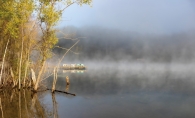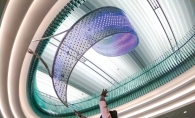Each spring the St. Croix Valley Studio Tour connects artists with their admirers, and as in years past, the 2016 artOPENer doesn’t disappoint, showcasing local art with an eclectic behind-the-scenes tour that opens studio doors to the public.
Held this year April 29–May 1, the weekend highlights more than 20 creators working within a 20-mile radius who range in artistic media and craft; the tour features nine studio stops that span both sides of the river, from Stillwater to River Falls, Wis. As a prelude, we’ve selected a small group of artists to introduce you to. Meet the person behind the craft, discover the lifestyle that supports the work, and catch a glimpse of the inspiration that drives each artist to create.
Lauri Wilson
Glass artist Lauri Wilson is in her studio every day by 9 a.m. and works until 3 p.m. A mother of two young children, ages 4 and 8, Wilson keeps to structured work hours in her backyard studio behind her River Falls home. “Having children and being an artist has forced me to be creative on a schedule,” Wilson says with a chuckle.
If you visit, you will see that her work reflects what she sees in the environment. “I’ve been inspired by nature forever,” Wilson says. “I’m always looking”—and a glimpse out of her studio window shows what she sees: trees, birds and rocks, even a one-time waterfall.
But if her muse is nature, her medium is glass. Wilson’s been working with glass for 25 years. She was first introduced to the medium at the University of Wisconsin–River Falls, and after that she worked for years making stained glass windows for new houses, but changed direction in 2008 to focus entirely on making fused-glass pieces. Now her work lives primarily in galleries or is commissioned to hang in hospitals or on clinic walls.
To create her abstract glass landscapes, Wilson will lay out sheets of glass on the kiln shelf. Manipulating the glass while cold, she then incorporates frit (broken glass pieces) and glass powder to create the surface design. She describes what it looks like before the work goes into the kiln: “It kind of looks like a sand painting on top of a puzzle made of glass.”
Wilson blends two opposing qualities into her work: structure and spontaneity. She is detail-oriented and precise, yet can simultaneously be loose and painterly with her design work. She enjoys the technical challenge and rules that accompany the medium, but also loves the free-spirited process creating the surface design.
Marjorie Wade
Ceramic artist Marjorie Wade generally works best starting at 10 a.m., but those hours will shift depending on what she needs to get done. From her studio in Stillwater, Wade makes functional pottery and feels connected to the handmade objects: “I think when people can incorporate any type of handmade work into their life, it is so enriching.”
Wade has been transfixed by clay since elementary school when she made her first pot; however, it wasn’t until 1998 when she began her formal training. Starting classes at Phipps Center for the Arts in Hudson, her studies led her to the Northern Clay Center in Minneapolis and eventually to the University of Wisconsin–River Falls the past three years.
Working primarily with stoneware, Wade makes work through a combination of wheel-throwing and hand-building. Her work is textured and reflects a natural spirit: no two pieces look the same. “I am an identical twin,” she says with a laugh. “That’s maybe why I try so hard to be different.” She explains that in a series of bowls, cups or any other form, “if they are too similar, I will change the height of one slightly, the texture slightly, the glaze differently.”
Wade likes to keep things simple: Using only two glazes with an iron-rich slip underneath, her color palette is earthy. Wade honors elements at play outside herself and tries to remove her ego from the art, as reflected in the Spiritworks name. “To me, the elements of nature—earth, water, fire, air—are all very important and all work together,” she says. “Although I fashion the pots, there is so much else happening to form the art.”
Robbin Firth
Fiber artist Robbin Firth finds the quiet time when her studio is closed and there is less traffic helpful to her inspiration process, and this often comes in the afternoon. Firth has been making fiber art for 24 years; for the past three, she has been working full time out of her studio space at Seasons on St. Croix Gallery in Hudson.
Starting out as a knitter, then a spinner, Firth works with felting techniques in innovative ways. A self-taught artist who creates a diverse body of work, Firth describes her process as “a whole mixed media unto itself.” From a variety of colorful fabric or cloth, she can make anything from dresses to wall art to sculpture.
Rejecting traditional felting methods, Firth came up with a tool that allows her to work in a nontraditional way. The tool—the Palm Washboard—is used to bond the various fibers together in the final steps of the wet-felting process. Firth and her husband, wood artist Harry Firth, created the tool together (patent pending)—Harry hand-crafts the tool, and Robbin uses it in her classes and work.
To create her vibrant pieces, Firth uses a variety of fibers ranging from wool from local sheep farmers to fibers imported from places like Australia, Europe and Asia. The artist is inspired by colors and textures found in earth, trees and water, and operates free form with her color palette. “There’s the element of surprise,” she says. “Color patterns are so freeing—you never know what you are going to get.”
Charlotte Schuld
Painter Charlotte Schuld is a morning person. She wakes up like a light switch each day and ventures down to her Stillwater basement studio space to begin work, keeping a 9-to-5 studio schedule that often creeps into her evenings as she ponders paintings 24/7. “I don’t have the problem of what to paint,” Schuld says. “The problem is more when can I get to the next 12 ideas I have.”
Schuld is a landscape artist and a farmer’s daughter, with a deep appreciation for the land. “There is a never-ending supply of inspirational compositions with sky, land and water, and all the details that surround these,” Schuld says. She is inspired by nature and always has liked to draw.
Double-majoring with a teaching degree in vocal music and K–12 art from Dickinson State University, Schuld didn’t get serious about her painting until the 1980s, when she started making pastel portraits while staying at home with her two kids. She has worked with other painting techniques, but eventually found her current medium and subject matter in the early 2000s: acrylic paints and landscapes.
Painting scenes from both regional cites and destinations abroad, Schuld uses acrylics to paint the places she’s traveled to. She photographs the sites extensively and uses the photos as references back in her studio.
It takes many hours of thought, preparation and care to create her work, but Schuld is never bored by the process: “There’s something about hand-making the painting, stroke by stroke, that is so powerful and inviting,” she says. “It keeps people coming back and wanting to paint.”









